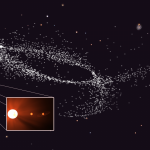W. M. Keck Observatory press release…
An international team of scientists, led by astronomers at Queen Mary University of London, report of two new planets orbiting Kapteyn’s star, one of the oldest stars found near the Sun. One of the newly-discovered planets could be ripe for life as it orbits at the right distance to the star to allow liquid water on its surface. The paper is being published by the Monthly Notices of the Royal Astronomical Society on June 4.

The astronomers used new data from the 3.6 meter La Silla Observatory in Chile to measure tiny periodic changes in the motion of the star, and followed up with two more high-precision spectrometers to secure the detection: W. M. Keck Observatory’s HIRES instrument installed on the 10-meter Keck I telescope on the summit of Mauna Kea, and PFS at the 6.5 meter Las Campanas Observatory in Chile.
Using the Doppler Effect, which shifts the star’s light spectrum depending on its velocity, the scientists can work out some properties of these planets, such as their masses and periods of orbit.
Continue reading “Ancient Worlds from Another Galaxy Discovered Next Door”
